With an extensive network of trails, experienced guides and porters, and jaw-dropping views of the highest mountains in the world, it’s no surprise that the Himalayas in Nepal are the beating heart of the world’s hiking and backpacking adventures. But with hiking holidays becoming ever more popular, you won’t be the only one hitting the trails there. There are alternative treks, though, where you can still find that deep connection with nature away from the crowds and get to know the warm locals who live on the Himalayan slopes.
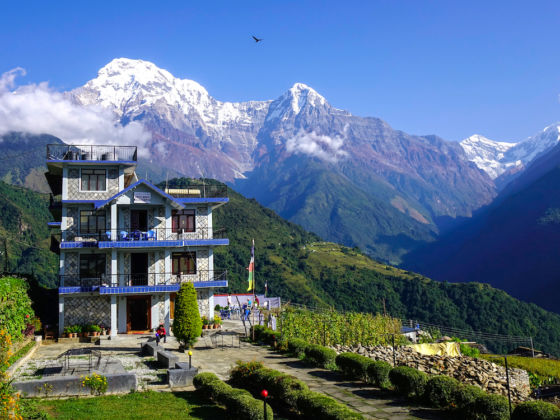

5 Alternative Teahouse Treks in Nepal With No Crowds
Nepal has seen a huge spike in visitors since the earthquake in 2015, with over one million tourists flying into Kathmandu in 2018 alone. With the demands of the ever-flowing foot traffic, what were once simple teahouses and remote mountain trails have been transformed into busy, commercial enterprises. Treks with well-known names such as the Annapurna Circuit and Everest Base Camp see thousands of trekkers each season, which can make for crammed teahouses, traffic jams on the trails, and overpriced dal bhat (Nepal’s favorite meal of rice, dahl, and vegetables). Check out these other treks, and you’ll find the serenity and local connection you seek.
What is teahouse trekking?
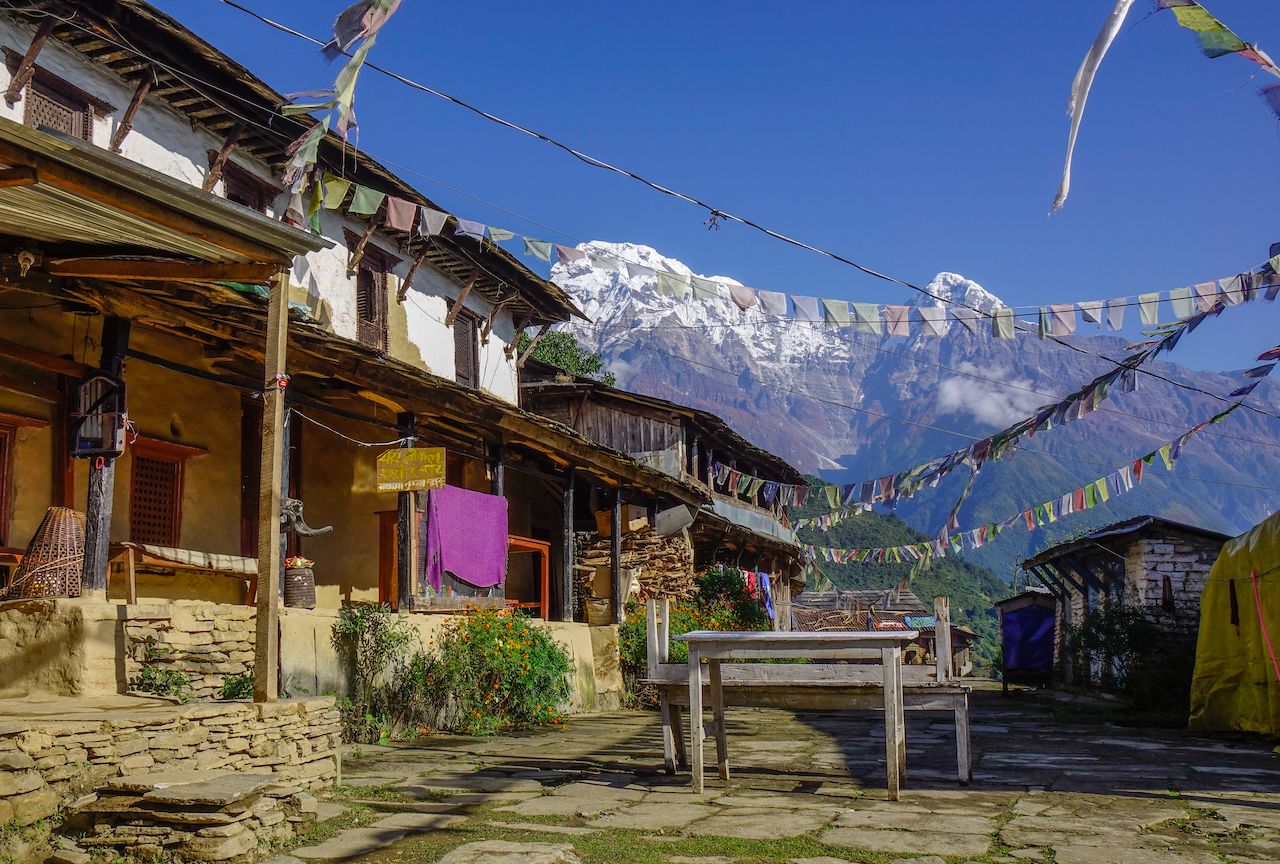
Photo: Phuong D. Nguyen/Shutterstock
Teahouse trekking is the most common way people explore the Himalayas in Nepal. Across the national parks of Langtang and Sagarmatha and the Annapurna Conservation Area, an extensive network of teahouses or lodges offers basic meals and beds to hungry and tired trekkers. The beauty of teahouse trekking is that it minimizes much of the need to carry camping and cooking equipment or plan extensive logistics like campsites. On most treks in these parks, you barely have to walk for an hour or two before coming across another teahouse, and usually at the popular overnight stops, you’ll find a whole cluster of them offering relatively similar menus and rooms.
1. Khopra Ridge/Khayer Lake trek (Annapurna Conservation Area)
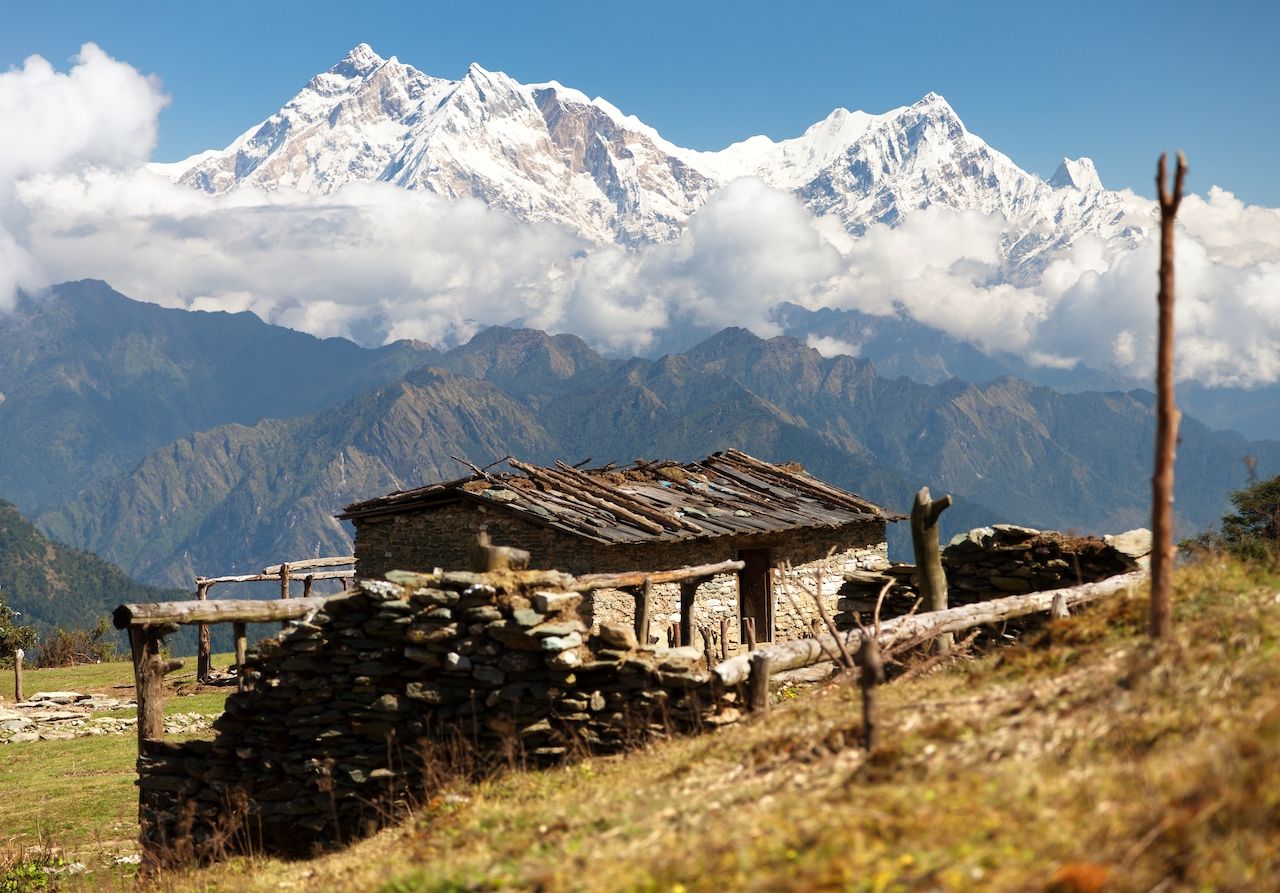
Photo: Daniel Prudek/Shutterstock
Highest point: Khopra Ridge: 11,940 feet (14,800 feet if you go to Khayer Lake)
Time required: five-eight days
This is perhaps one of the least-known teahouse treks in Nepal. If you mention to someone that you’re considering hiking Khopra Ridge, you’ll most likely get a response of, “What? Where?” It’s technically a part of the network of community treks created by Mahabir Pun, the social entrepreneur best known for bringing internet to rural Nepal. Some of the teahouses here are community-run, and the money they generate goes back into supporting schools and health clinics in nearby villages. True to Mahabir’s tech aspirations, the lodge at Khopra Ridge even has decent WiFi, which seems like a real treat at 11,900 feet.
The trek generally starts in Nayapul, the same trailhead as for the popular Poon Hill and Annapurna Base Camp treks. It initially follows the Poon Hill trail, so for the first two days you’ll follow a conga line of other trekking groups and mule caravans on your way to Ghorepani.
From there, the way to Khopra Ridge diverts off the main route, and it’s following this minor trail that you’ll come to realize the joys of being on a lesser-known trek. As the path winds further away from village life and deeper into the Annapurna Conservation Area, you’ll pass fewer people along the way. The final push up to Khopra Ridge is relatively steep, but you’ll have Mount Dhaulagiri, the seventh highest peak in the world, appearing closer in front of you like a northern star guiding the way.
From the community teahouse perched on the plateau at Khopra Ridge, there is perhaps the best view of Mount Dhaulagiri in the entire region, as well as Annapurna South seeming almost close enough to touch. From Khopra it is possible, depending on the season, to take a long day hike to Khayer Lake, a spectacular high-altitude, fluorescent-blue lake sitting at 14,800 feet.
From Khopra, you have two options to return to Pokhara. The shorter route means taking the trail down to Tatopani where it’s possible to get transport. If you have a couple of extra days, you can take the longer route to the teahouses at Dobato. From there, a short scramble leads to Muldai Viewpoint, which provides a panorama arguably as good as Poon Hill that, in comparison, you’re likely to share with very few other trekkers.
You’ll be able to see Dhaulagiri, Annapurna I, and Machhapuchhre, better known as Fishtail, laid out in front of you in a wide, sweeping vista. Then you can head down to Ghandruk and back to Pokhara or even join onto one of the other treks, such as Mardi Himal or Annapurna Base Camp, if you still have the energy.
2. Mardi Himal trek (Annapurna Conservation Area)
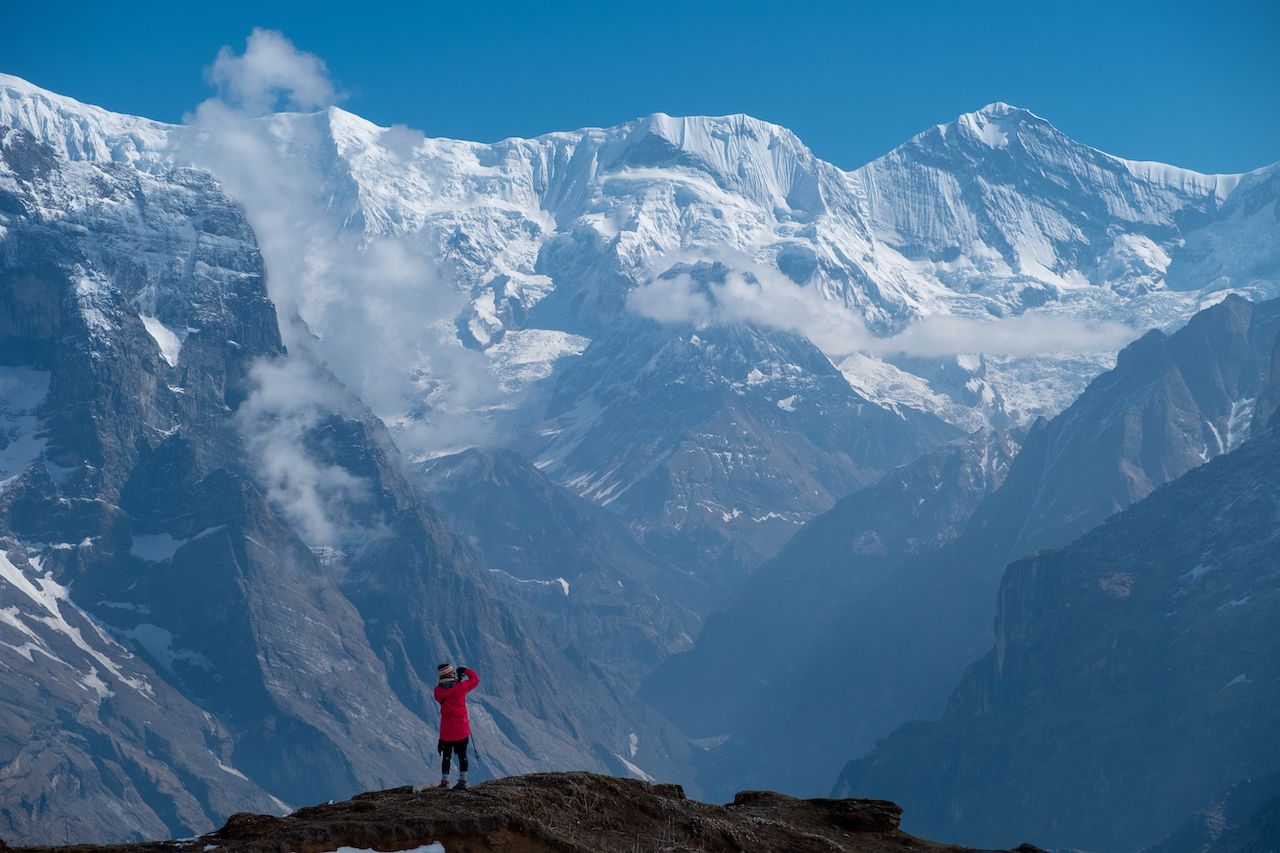
Photo: Devin Tolleson/Shutterstock
Highest point: Mardi Himal Base Camp: 14,800 feet
Time required: four-six days
The Mardi Himal trek is fast emerging as one of the new favorites in Nepal. However, it still sees far less foot traffic than it’s neighbor, Annapurna Base Camp. It’s a trek that climbs through forest and rhododendron fields along a ridge to the base of Mardi Himal, a relatively small peak on the edge of the Annapurna range. It’s the best pick for those short on time because for a relatively quick trek it packs a whole lot of punch in terms of mountain views.
Most people begin the trek from Kande, a short drive from Pokhara, and take overnight stops in Forest Camp, Low Camp, and High Camp along the way. From High Camp, if the trails are cleared of snow, most people trek to Mardi Himal Base Camp and back as a day trip. It’s by far the toughest day of the trek and requires you to ascend around 3,300 vertical feet to Base Camp before descending back the same way. However, the thinner air and leg-breaking climb are small prices to pay for the stunning up-close views of Mardi Himal and Machhapuchhre, as well as across the Annapurna Massif. You can also seemingly look down onto Annapurna Base Camp, which is hidden in the valley not far down below.
Some consider the trek to be “easy.” In fact, you should not underestimate the steep ascents and descents, particularly if you head all the way to Mardi Himal Base Camp at 14,800 feet. You’ll also find fewer luxuries on this trek, as the teahouses generally operate purely for the trekking seasons, and there are no permanent settlements along the way.
3. Tamang Heritage Trail (Langtang National Park)

Photo: Marcel Krol Fotografie/Shutterstock
Highest point: 10,100 feet
Time required: seven days
The Tamang Heritage Trail was designed for those who are after a more authentic cultural experience while hiking in the Himalayas. It started as a community-based social development project that offers something different than the standard teahouse treks and is aimed at providing alternative income for the local Tamang people. Rather than feeling like you are simply a customer in a commercial trekking lodge, you’ll be treated almost like a family member in the more traditional homestay-style teahouses, with your money directly benefiting the communities.
It’s situated in the Langtang region, one of the areas hardest hit by the 2015 earthquake. Your contribution can go a long way to helping those who are still recovering. The Tamang people are Tibetan descendants who began settling in Nepal around 3,000 years ago and constitute one of the largest ethnic minorities in the country. Tamang, which means “horse warriors,” have a unique Tibetan Buddhist culture and are extremely welcoming people who are always willing to share their traditions and stories around the yak-dung-fired heater at night.
The starting point for this circuit trek is in Syabrubesi town, which is a long drive north of Kathmandu and the main trailhead for most treks in the Langtang region. The trail takes you through old villages surrounded by terraced farmland, where you can see the day-to-day activities of the locals, as well as visit some of the small gompas, or Buddhist monasteries, along the way.
It’s a relatively gentle trek at a much lower altitude than some of the other trails in the region. However, you can still get a glimpse of some of the snow-capped peaks of the nearby Ganesh and Langtang Ranges from various viewpoints along the way. It’s a perfect first trek for those who are not yet acclimatized or physically prepared and is often followed by another, more challenging trek in the Langtang National Park.
4. Gosaikunda Helambu trek (Langtang National Park)
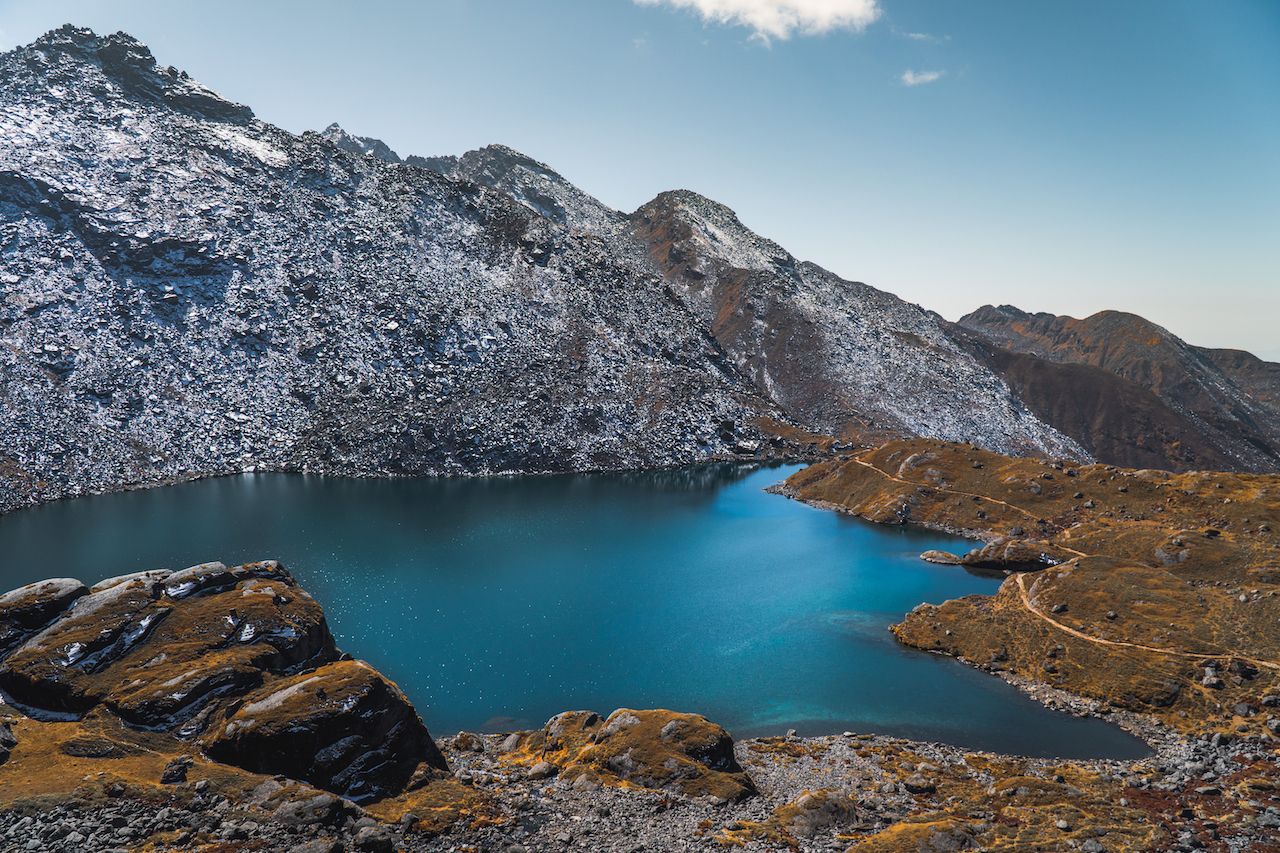
Photo: Manish23/Shutterstock
Highest point: Laurebina Pass: 15,100 feet
Time required: eight days
Gosaikunda Lake is one of the most important pilgrimage sites for both Hindus and Buddhists in Nepal. One of 108 glacial lakes in the area, this particular lake is believed to have been created by Lord Shiva when he tried to find drinking water to soothe his throat after consuming poison. Hindus believe that bathing in its water will help wash their sins and sorrows away.
The lake itself can be done as a short trek out and back from Dhunche, a village not far from Syabrubesi, the main trailhead in the Langtang National Park. However, the real beauty of this trek is that you can begin in Dhunche and continue all the way back to Kathmandu on foot, taking around eight days. It’s also possible to add this on to the end of the popular five-day Langtang Valley trek, which turns it into a truly impressive excursion and one very few people undertake.
It’s a relatively steep ascent through forest for the first few days from Dhunche to reach Gosaikunda, and it’s important to take it easy, or you may otherwise suffer from the rapid change in altitude. The holy lake seems to be sitting almost in a bowl created by the surrounding slopes, and the view of the snow-capped ranges in the distance is mesmerizing. From the lake the trek passes its highest point over Laurebina Pass at 15,100 feet before mostly being downhill over the subsequent days through forest, rhododendron trees, and Sherpa villages towards the Kathmandu Valley.
Although the Himalayas highest peaks are quite a distance away in the Annapurna and Sagarmatha regions, don’t underestimate the vistas in Langtang National Park. You will also definitely appreciate that Langtang is the least-visited park of the three popular teahouse trekking regions.
5. Gokyo trek (Sagarmatha/Everest National Park)
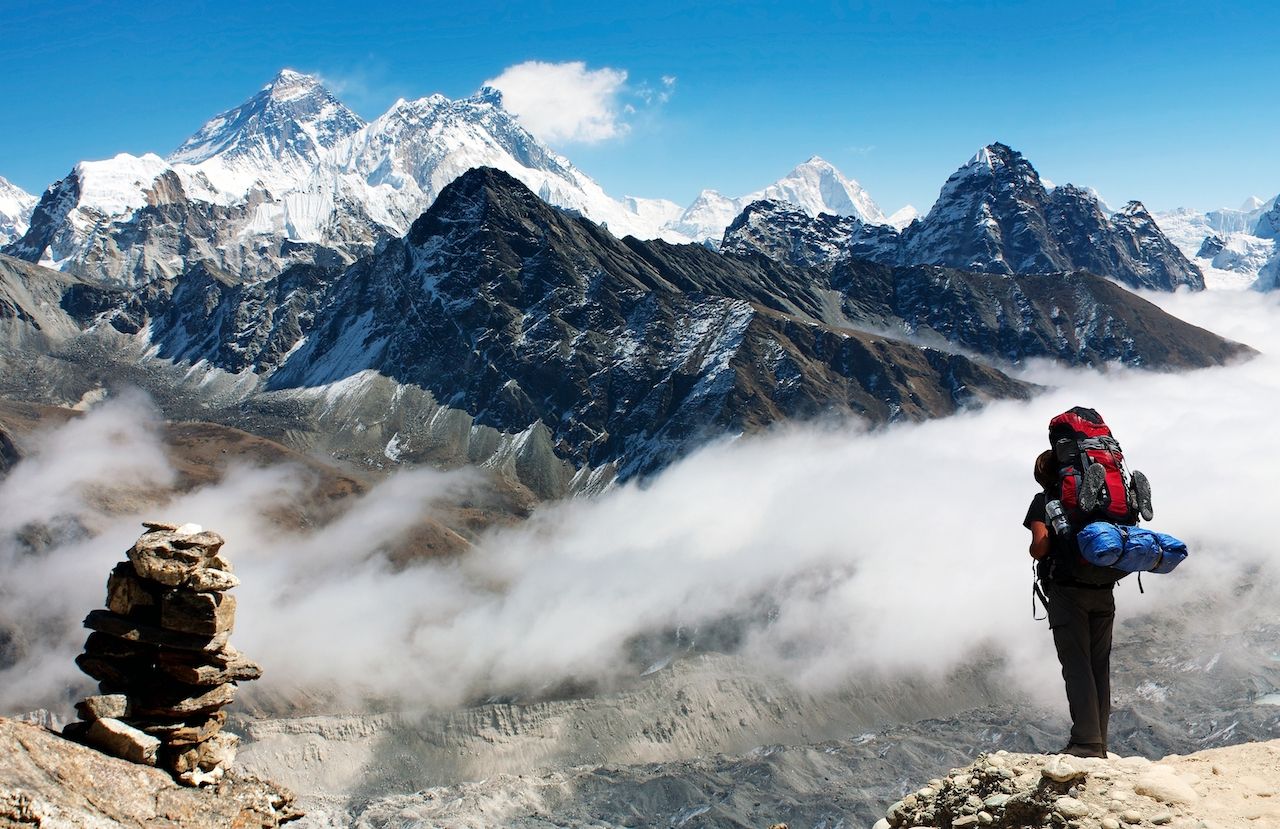
Photo: Daniel Prudek/Shutterstock
Highest point: Gokyo Ri: 17,575 feet
Time required: 12 days
In many people’s eyes, there is only one trek to do in Sagarmatha National Park, and that is of course Everest Base Camp (EBC). Considered a must-do, bucket-list experience, EBC is one of the most popular treks in Nepal and is soon expected to reach 50,000 trekkers every year. However, there is in fact another trek in the same national park that will take you just as high as EBC but with significantly fewer crowds to contend with.
Gokyo is only recently starting to make a name for itself and will likely become an equally popular trek in the future. For now ,it still flies smoothly under the radar. It’s technically a part of the challenging and lengthy Three Passes trek, but it has become a standalone hike in its own right through a spectacular valley north of Namche Bazaar.
Until Namche, the trail follows the same route as EBC, and you can gawk at just how many people head to the base of the roof of the world. From Namche, you will be relieved to leave the crowds behind and start your ascent up to Gokyo. The trek carries a high risk of Acute Mountain Sickness as you will be ascending 4,260 vertical feet in just 14.2 miles. The slower you go the better, and most people overnight in Dhole and Machermo on their way up in order to acclimatize appropriately.
On the final day approaching Gokyo, you will hike through an otherworldly landscape of blue glacial lakes among soaring snowy peaks. At 15,400 feet, it’s a rather chilly place. Within the cluster of teahouses, though, you’ll find a German bakery where you can warm yourself up with a hot drink and freshly baked cake.
The highlight of the trek is the half-day return hike up to Gokyo Ri, a peak and viewpoint above the Gokyo teahouse village. It’s a steep climb, but the reward is a view that is almost beyond imagination. Here, at arguably one of the best Himalayan vistas you can possibly get, you’ll be able to see Cho Oyu (the world’s sixth highest peak), Lhotse (the world’s fourth highest peak), Makalu (the world’s fifth highest), the beautiful Ama Dablam, and, of course, the mighty Everest. The best time to tackle Gokyo Ri is in the early morning. If you can handle the cold, a sunrise hike is even better.
From Gokyo you have many options. You can either take Cho La pass and join on to Everest Base Camp or take Renjo La pass and head back to Namche, or simply head back through the same valley you came up, taking the trail on the other side via Phortse to vary your return.